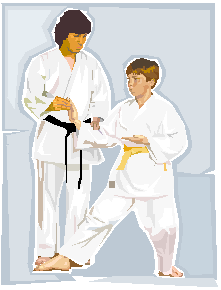Voici la saison des guillemots.
D'avril à la fin de mai, avant que les baigneurs parisiens arrivent, on voit
paraître soudain, sur la petite plage d'Étretat, quelques vieux messieurs
bottés, sanglés en des vestes de chasse.
Ils passent quatre ou cinq jours à
l'hôtel Hauville, disparaissent, reviennent trois semaines plus tard ; puis,
après un nouveau séjour, s'en vont définitivement.
On les revoit au printemps suivant.
Ce sont les derniers chasseurs de guillemots, ceux qui restent des anciens ; car ils étaient une vingtaine de fanatiques, il y a trente ou quarante ans ; ils ne sont plus que quelques enragés tireurs.
Le guillemot est un oiseau voyageur fort rare, dont les habitudes sont
étranges. Il habite presque toute l'année les parages de Terre-Neuve, des îles Saint-Pierre et Miquelon ; mais, au moment des amours, une bande d'émigrants traverse l'Océan, et, tous les ans, vient pondre et couver au même endroit, à la roche dite aux Guillemots, près d'Étretat. On n'en trouve que là, rien que là. Ils y sont toujours venus, on les a toujours chassés, et ils reviennent encore ; ils reviendront toujours. Sitôt les petits élevés, ils repartent, disparaissent pour un an.
Pourquoi ne vont-ils jamais ailleurs, ne choisissent-ils aucun autre point de cette longue falaise blanche et sans cesse pareille qui court du
Pas-de-Calais au Havre ? Quelle force, quel instinct invincible, quelle habitude séculaire poussent ces oiseaux à revenir en ce lieu ? Quelle première émigration, quelle tempête peut-être a jadis jeté leurs pères sur cette roche ? Et pourquoi les fils, les petit-fils, tous les descendants des premiers y sont-ils toujours retournés !
Ils ne sont pas nombreux : une centaine au plus, comme si une seule famille avait cette tradition, accomplissait ce pèlerinage annuel.
Et chaque printemps, dès que la petite tribu voyageuse s'est réinstallée sur sa roche, les mêmes chasseurs aussi reparaissent dans le village. On les a
connus jeunes autrefois ; ils sont vieux aujourd'hui, mais fidèles au rendez-vous régulier qu'ils se sont donné depuis trente ou quarante ans.
Pour rien au monde, ils n'y manqueraient.
C'était par un soir d'avril de l'une des dernières années. Trois des anciens tireurs de guillemots venaient d'arriver ; un d'eux manquait, M. d'Arnelles.
Il n'avait écrit à personne, n'avait donné aucune nouvelle ! Pourtant il
n'était point mort, comme tant d'autres ; on l'aurait su. Enfin, las d'attendre, les premiers venus se mirent à table ; et le dîner touchait à sa fin, quand une voiture roula dans la cour de l'hôtellerie ; et bientôt le retardataire entra.
Il s'assit, joyeux, se frottant les mains, mangea de grand appétit, et, comme un de ses compagnons s'étonnait qu'il fût en redingote, il répondit
tranquillement :
-Oui, je n'ai pas eu le temps de me changer.
On se coucha en sortant de table, car, pour surprendre les oiseaux, il faut partir bien avant le jour.
Rien de joli comme cette chasse, comme cette promenade matinale.
Dès trois heures du matin, les matelots réveillent les chasseurs en jetant du sable dans les vitres. En quelques minutes on est prêt et on descend sur le
perret. Bien que le crépuscule ne se montre point encore, les étoiles sont un peu pâlies ; la mer fait grincer les galets ; la brise est si fraîche qu'on frissonne un peu, malgré les gros habits.
Bientôt les deux barques poussées par les hommes, dévalent brusquement sur la pente de cailloux ronds, avec un bruit de toile qu'on déchire ; puis elles se balancent sur les premières vagues. La voile brune monte au mât,
se gonfle un peu, palpite, hésite et, bombée de nouveau, ronde comme un ventre, emporte les coques goudronnées vers la grande porte d'aval qu'on distingue vaguement dans l'ombre. Le ciel s'éclaircit ; les ténèbres semblent fondre ; la côte paraît voilée encore, la grande côte blanche, droite comme une muraille.
On franchit la Manne-Porte, voûte énorme où passerait un navire ; on
double la pointe de la Courtine ; voici le val d'Antifer, le cap du même
nom ; et soudain on aperçoit une plage où des centaines de mouettes sont posées.
Voici la roche aux Guillemots.
C'est tout simplement une petite bosse de la falaise ; et, sur les étroites corniches du roc, des têtes d'oiseaux se montrent, qui regardent les
barques.
Ils sont là, immobiles, attendant, ne se risquant point à partir encore.
Quelques-uns, piqués sur des rebords avancés, ont l'air assis sur leurs
derrières, dressés en forme de bouteille, car ils ont des pattes si courtes qu'ils semblent, quand ils marchent, glisser comme des bêtes à roulettes ;
et, pour s'envoler, ne pouvant prendre d'élan, il leur faut se laisser tomber comme des pierres, presque, jusqu'aux hommes qui les guettent.
Ils connaissent leur infirmité et le danger qu'elle leur crée, et ne se décident pas à vite s'enfuir.
Mais les matelots se mettent à crier, battent leurs bordages avec les tolets de bois, et les oiseaux, pris de peur, s'élancent un à un, dans le vide,
précipités jusqu'au ras de la vague ; puis, les ailes battant à coups rapides, ils filent, filent et gagnent le large, quand une grêle de plombs ne les jette
pas à l'eau. Pendant une heure on les mitraille ainsi, les forçant à déguerpir l'un après l'autre ; et quelquefois les femelles au nid, acharnées à couver, ne s'en vont point ; et reçoivent coup sur coup les décharges qui font jaillir
sur la roche blanche des gouttelettes de sang rose, tandis que la bête expire
sans avoir quitté ses oeufs.
Le premier jour, M. d'Arnelles chassa avec son entrain habituel ; mais, quand on repartit vers dix heures, sous le haut soleil radieux, qui jetait de grands triangles de lumière dans les échancrures blanches de la côte, il se montra un peu soucieux, rêvant parfois, contre son habitude.
sourc: audiocite
Image: http://nl.wikipedia.org/wiki/Bestand:August_Alleb%C3%A9_-_De_vlinders.jpg


























